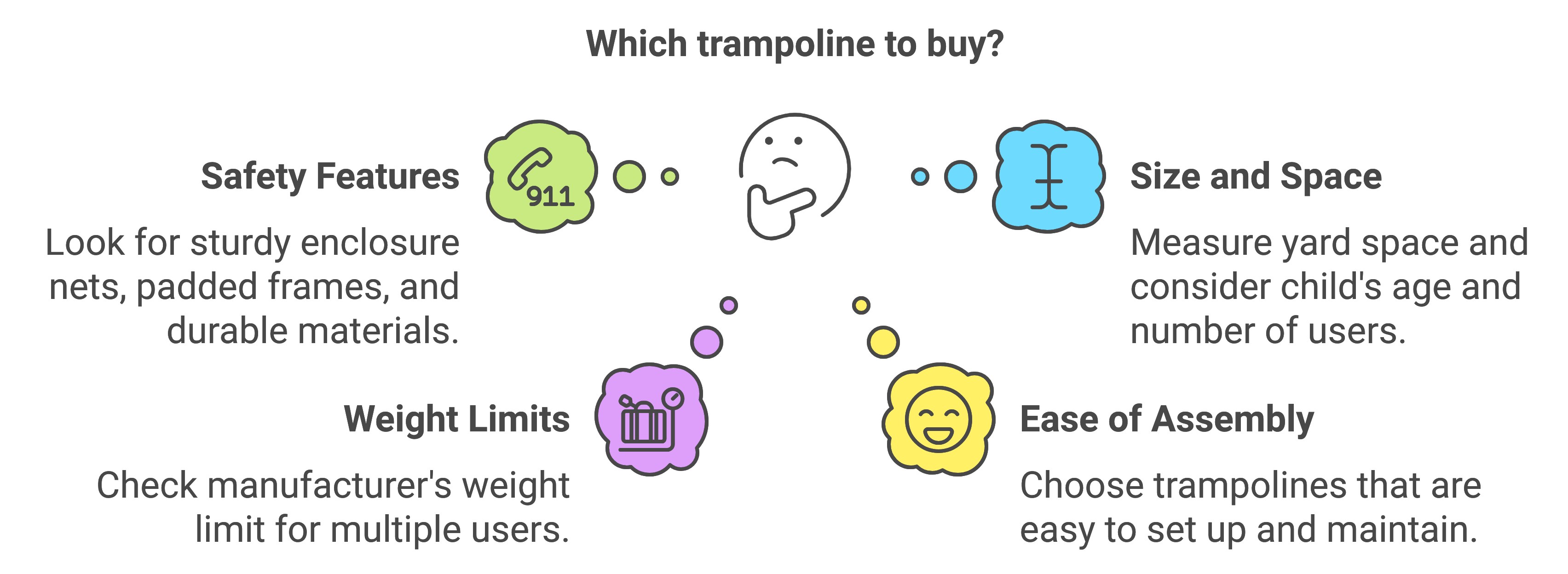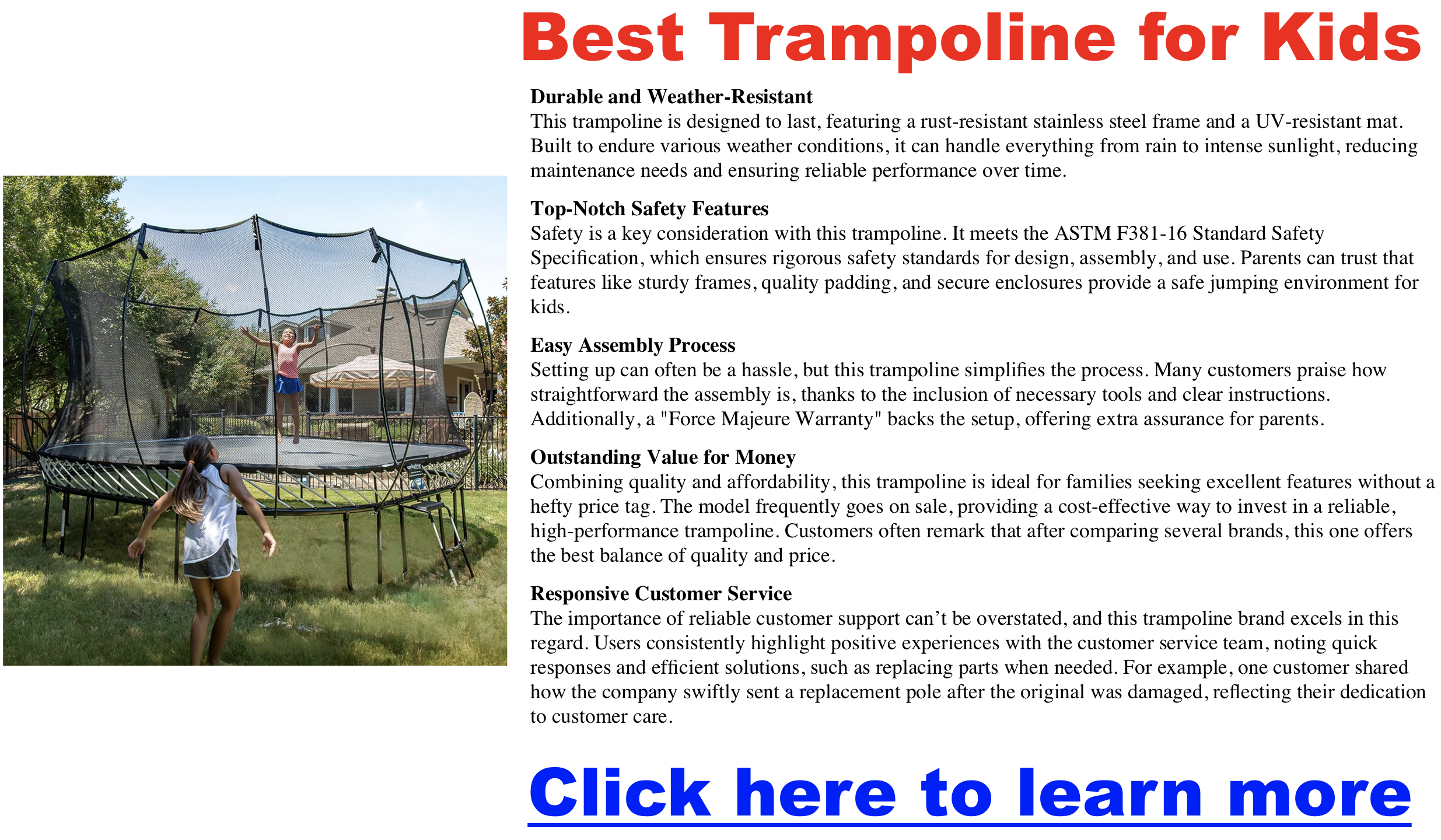The Ultimate Trampoline Buying Guide: Find the Perfect Bounce for Your Family
Buying a trampoline can be overwhelming. With so many shapes, sizes, features, and safety standards, it’s easy to get lost in the bounce. This guide will help you find the perfect trampoline for your family by walking you through who will be using it, how much space you need, what safety features to prioritize, and which brands to trust.
Who Will Be Jumping?
| User Type | Recommended Trampoline | Special Considerations |
|---|---|---|
| Young children (< 10) | 8–10 ft Round | Safety net, padded springs, low height |
| Families / Casual use | 12–14 ft Round or Oval | Space for multiple users, moderate bounce |
| Teens / Gymnasts | 15+ ft Rectangle or Oval | High bounce, durability, advanced safety features |
Mini Trampolines for Babies and Toddlers
Choosing the Best Trampoline for Someone with Autism
Measuring Your Space
Before buying, measure the area where your trampoline will go:
- Ground clearance: Leave at least 2 feet on all sides.
- Overhead clearance: Minimum of 24 feet to avoid trees and wires.
Example: A 14 ft trampoline needs ~18 ft diameter space including clearance.
How to Install an In-Ground Trampoline
What to Look for in a Backyard Trampoline
Choosing Shape & Size
| Shape | Best For | Pros | Cons |
|---|---|---|---|
| Round | General use / Families | Safer, pulls jumpers to center | Less powerful bounce |
| Rectangle | Gymnasts / Athletes | Strong bounce, good for tricks | More expensive |
| Oval | Families w/ multiple users | Wide surface, fewer collisions | Moderate bounce height |
| Square | Controlled bouncing zones | Balanced space and bounce | Higher price, less common |
Top 7 Best Rectangle Trampolines
The Ultimate Buying Guide for Square Trampolines
Trampoline Safety Features
- Net enclosure: Prevents falls, especially for younger jumpers
- Padded springs/poles: Reduces impact injuries
- Rust-resistant frame: Extends longevity and performance
- Certifications: Look for ASTM, TÜV, or equivalent safety compliance
Are Trampolines Really Safe for Kids?
Safest Trampoline Brands & Safety Rules
Spring vs Springfree Trampoline
Understanding Budget and Value
| Size | Price Range | Recommended For |
|---|---|---|
| Small (8–10 ft) | $200–$900 | Young kids, small yards |
| Medium (12–14 ft) | $400–$1500 | Most families, casual use |
| Large (15+ ft) | $1000–$3000 | Teens, gymnasts, trick jumpers |
Trampoline Pricing & Finding The Best Deal
Trampoline Costs Guide
Must-Have Accessories
- Ladders – Easy access for kids
- Weather covers – Protects from UV and rain
- Anchor kits – Prevents movement during wind
Best Trampoline Covers
Trampoline Ladder Guide
Trampoline Accessories
Setup & Maintenance Tips
- Set up on flat, debris-free ground
- Tighten bolts monthly
- Use covers in winter or disassemble
Maintenance & Care Guide
Cleaning Your Trampoline
Trusted Trampoline Brands
- Springfree – Industry-leading safety
- Skywalker – Great budget-friendly option
- Zupapa – High quality with accessories
Springfree Buying Guide
Zupapa Review
Skywalker Trampoline Guide
FAQs: Quick Answers Before You Buy
Q: Are trampolines safe for young kids?
A: Yes—with a safety net, padded springs, and adult supervision.
Q: How long do trampolines last?
A: 5–10 years with proper care. Learn more
Q: What makes Springfree so safe?
A: No exposed springs, hidden frame, flexible rods instead of steel coils.
Q: Do trampolines need professional installation?
A: Most can be assembled at home. In-ground models may need professional help.
Q: What’s the best way to protect a trampoline from weather?
A: Use a cover, anchor it, and store parts in harsh winters.
Final Thoughts
Choosing the right trampoline means balancing safety, space, budget, and performance. Use this guide as your go-to checklist—and don’t forget to explore our deep-dive articles linked throughout for help comparing models, accessories, and long-term value.


